Related Research Articles

The Malacca Sultanate was a Malay sultanate based in the modern-day state of Malacca, Malaysia. Conventional historical thesis marks c. 1400 as the founding year of the sultanate by King of Singapura, Parameswara, also known as Iskandar Shah, although earlier dates for its founding have been proposed. At the height of the sultanate's power in the 15th century, its capital grew into one of the most important transshipment ports of its time, with territory covering much of the Malay Peninsula, the Riau Islands and a significant portion of the northern coast of Sumatra in present-day Indonesia.
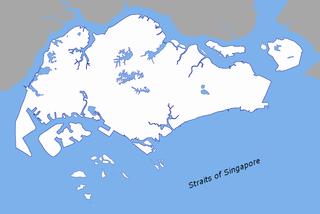
The Singapore Strait is a 113 km-long (70 mi), 19 km-wide (12 mi) strait between the Strait of Malacca in the west and the South China Sea in the east. Singapore is on the north of the channel, and the Indonesian Riau Islands are on the south. The two countries share a maritime border along the strait.

The Johor Sultanate was founded by Sultan of Malacca Mahmud Shah's son, Alauddin Riayat Shah II in 1528.
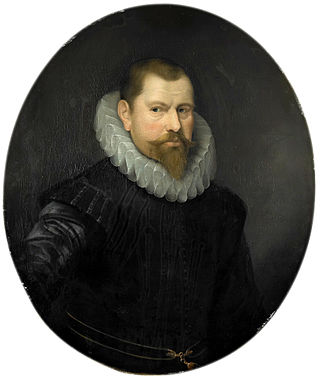
Cornelis Matelief de Jonge was a Dutch admiral who was active in establishing Dutch power in Southeast Asia during the beginning of the 17th century. His fleet was officially on a trading mission, but its true intent was to destroy Portuguese power in the area. The fleet had 1400 men on board, including 600 soldiers. Matelieff did not succeed in this. The Dutch would ultimately gain control of Malacca more than thirty years later, again joining forces with the Sultanate of Johor, and a new ally Aceh, in 1641. He was born and died in Rotterdam.

Santa Catarina was a Portuguese merchant ship, a 1500-ton carrack, that was seized by the Dutch East India Company on 25 February 1603 off Singapore. She was such a rich prize that her sale proceeds increased the capital of the VOC by more than 50%. From the large amounts of Ming Chinese porcelain captured in this ship, Chinese pottery became known in Holland as Kraakporselein, or "carrack-porcelain" for many years.

Tanjung Tuan is an area in Alor Gajah District, Malacca, Malaysia. It is a semi-exclave of Malacca adjacent to Port Dickson, Negeri Sembilan.
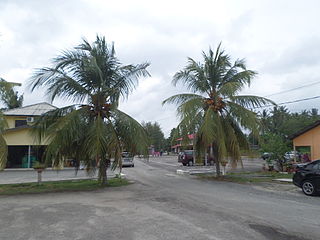
Johor Lama is a mukim in Kota Tinggi District, Johor, Malaysia. It is situated on the banks of Johor River. It was once a thriving port and the old capital of the Johor Sultanate.

The early history of Singapore refers to its pre-colonial era before 1819, when the British East India Company led by Stamford Raffles established a trading settlement on the island and set in motion the history of modern Singapore.
Juan de Silva was a Spanish military commander and governor of the Philippines, from April 1609 until his death on April 19, 1616.

The Battle of Cape Rachado, off Cape Rachado in 1606, was an important naval engagement between the Dutch East India Company (VOC) and Portuguese Navy.

Martim Afonso de Castro was a Portuguese Viceroy of India. He commanded the Portuguese Navy in the Battle of Cape Rachado and fought over the present day Malaccan exclave of Tanjung Tuan in 1606.
Tun Muhammad bin Tun Ahmad, better known as Tun Sri Lanang, was the Bendahara of the royal Court of Johor Sultanate who lived between the 16th and 17th centuries. He served under two Sultans of Johor, namely; Sultan Ali Jalla Abdul Jalil Shah II (1570–1597) and Sultan Alauddin Riayat Shah III (1597–1615) and also advisers to 3 Acheh sultans namely; Sultan Iskandar Muda, Sultan Iskandar Thani (1636–1641) and Sultana Tajul Alam Safiatuddin Shah (1641–1675). He had two honorific titles throughout his lifetime; as the Bendahara of Johor, Bendahara Paduka Raja Tun Mohamad, while he was given the title of Orang Kaya Dato' Bendahara Seri Paduka Tun Seberang after settling in Aceh.
Sultan Alauddin Riayat Shah III was the Sultan of Johor who reigned from 1597 to 1615. He resided at the new capital of Johor at Batu Sawar, but later moved his administration to Pasir Raja around 1609. In 1612, at the instigation of his co-ruler and half-brother Abdullah, and Bendahara Tun Sri Lanang oversaw the editorial and compilation process of the Sejarah Melayu, the most important Malay literary work of all time.
Sultan Abdullah Ma'ayat Shah was Sultan of Johor from 1615 to 1623. Before he became sultan of Johor, Abdullah Ma'ayat Shah was also known as Raja Bongsu, Raja Seberang or Raja di Hilir. Kota Seberang was described as the personal "fiefdom" of Raja Bongsu by Admiral Matelieff. He controlled the settlement which was located almost straight across the Johor River from the royal administrative center and capital Batu Sawar. He is also said to have controlled areas around the Sambas River on the island of Borneo.
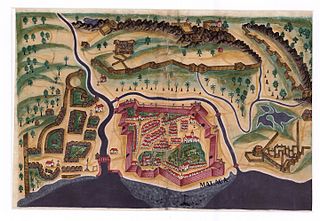
The Battle of Duyon River was a naval engagement between the Portuguese forces commanded by Nuno Álvares Botelho, who is renowned in Portugal as one of the last great commanders of Portuguese India, and the forces of the Sultanate of Aceh, which were led by the Laksamana.
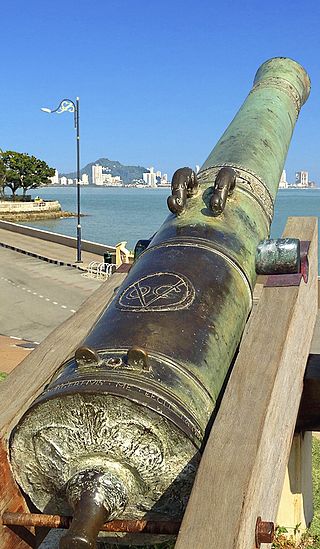
The Seri Rambai is a seventeenth-century Dutch cannon displayed at Fort Cornwallis in George Town, the capital city of the Malaysian state of Penang and a UNESCO World Heritage Site. It is the largest bronze gun in Malaysia, a fertility symbol and the subject of legends and prophecy.
The Battle of Ugentana, also known as Battle of Ugentana River was a military operation that took place in 1535, between Portuguese forces and those of Sultan Alauddin Riayat Shah II of Johor.
The Second Battle of Ugentana, was a military operation that took place in 1536, between Portuguese forces and those of Sultan Alauddin Riayat Shah II of Johor.

Malay–Portuguese conflicts were military engagements between the forces of the Portuguese Empire and the various Malay states and dynasties, fought intermittently from 1509 to 1641 in the Malay Peninsula and Strait of Malacca.

Acehnese–Portuguese conflicts were the military engagements between the forces of the Portuguese Empire, established at Malacca in the Malay Peninsula, and the Sultanate of Aceh, fought intermittently from 1519 to 1639 in Sumatra, the Malay Peninsula or the Strait of Malacca. The Portuguese supported, or were supported, by various Malay or Sumatran states who opposed Acehnese expansionism, while the Acehnese received support from the Ottoman Empire and the Dutch East India Company.
References
- ↑ Borschberg, Peter (2014-12-29). Jacques de Coutre's Singapore and Johor 1594-c.1625. NUS Press. ISBN 978-9971-69-852-2.
- ↑ Andaya, Barbara Watson; Andaya, Leonard Y. (2017-09-16). A History of Malaysia. Bloomsbury Publishing. ISBN 978-1-350-30669-1.
- ↑ Riyanto, Slamet; Afifatun, Siti (2023-02-13). Encyclopedia Series For Indonesian Children The Beauty Of Sumatera Island That Indonesian Children Need To Know. Penerbit Andi. ISBN 978-623-8186-04-4.
- ↑ Borschberg, Peter (2014-12-29). Jacques de Coutre's Singapore and Johor 1594-c.1625. NUS Press. ISBN 978-9971-69-852-2.
- ↑ Andaya, Barbara Watson; Andaya, Leonard Y. (2017-09-16). A History of Malaysia. Bloomsbury Publishing. ISBN 978-1-350-30669-1.
- ↑ Riyanto, Slamet; Afifatun, Siti (2023-02-13). Encyclopedia Series For Indonesian Children The Beauty Of Sumatera Island That Indonesian Children Need To Know. Penerbit Andi. ISBN 978-623-8186-04-4.
- ↑ Saturnino Monteiro (2011), Portuguese Sea Battles 1580-1603 pp.170-174
- ↑ Saturnino Monteiro (2011), Portuguese Sea Battles 1580-1603 pp.176-179